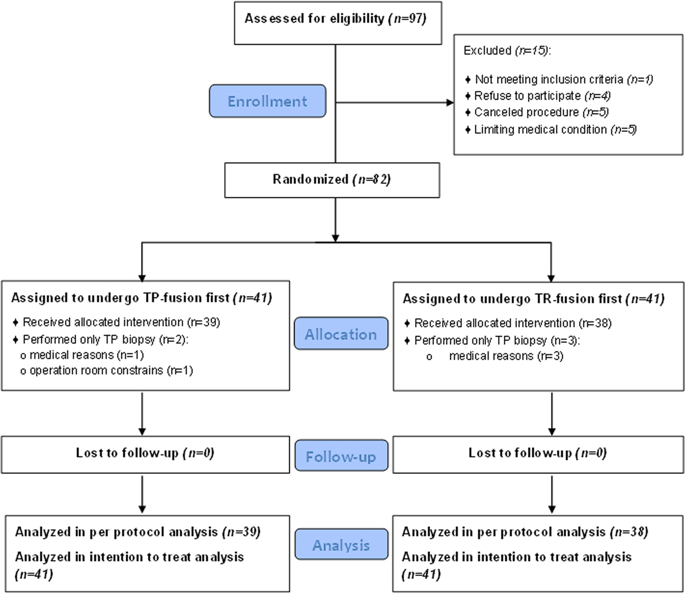当前位置:
X-MOL 学术
›
Prostate Cancer Prostatic. Dis.
›
论文详情
Our official English website, www.x-mol.net, welcomes your
feedback! (Note: you will need to create a separate account there.)
A noninferiority within-person study comparing the accuracy of transperineal to transrectal MRI-US fusion biopsy for prostate-cancer detection.
Prostate Cancer and Prostatic Diseases ( IF 5.1 ) Pub Date : 2020-01-17 , DOI: 10.1038/s41391-020-0205-7 Yaara Ber 1 , Niv Segal 1, 2 , Shlomit Tamir 3 , Ofer Benjaminov 4 , Maxim Yakimov 5 , Sivan Sela 1 , Daniel Halstauch 1 , Jack Baniel 1, 2 , Daniel Kedar 1 , David Margel 1, 2
Prostate Cancer and Prostatic Diseases ( IF 5.1 ) Pub Date : 2020-01-17 , DOI: 10.1038/s41391-020-0205-7 Yaara Ber 1 , Niv Segal 1, 2 , Shlomit Tamir 3 , Ofer Benjaminov 4 , Maxim Yakimov 5 , Sivan Sela 1 , Daniel Halstauch 1 , Jack Baniel 1, 2 , Daniel Kedar 1 , David Margel 1, 2
Affiliation

|
BACKGROUND
Magnetic resonance imaging (MRI) and ultrasound (US) fusion prostate-biopsies can be performed in a transrectal (TR-fusion) or transperineal (TP-fusion) approach. Prospective comparative evidence is limited. In this study we compared the detection rate of clinically-significant prostate-cancer (csPCa) within an index lesion between TR and TP-fusion.
PATIENTS AND METHODS
This was a prospective, noninferiority, and within-person trial. Men scheduled for MRI-US-fusion with a discrete MRI PI-RRAD ≥ 3 lesion were included. A dominant index lesion was determined for each subject and sampled by TR and TP-fusion during the same session. The order of biopsies was randomized and equipment was reset to avoid chronological and incorporation bias. For each subject, the index lesion was sampled 4-6 times in each approach. All biopsies were performed using Navigo fusion software (UC-Care, Yokneam, Israel). csPCa was defined as: Grade Group ≥ 2 or cancer-core length ≥ 6 mm. We used a noninferiority margin of 10% and a one-sided alpha level of 5%.
RESULTS
Seventy-seven patients completed the protocol. Median age was 68.2 years (IQR:64.2-72.2), median PSA was 8.9 ng/ml (IQR:6.18-12.2). Ten patients (13%) were biopsy naive, others (87%) had a previous biopsy. csPCa was detected in 32 patients (42%). All of these cases were detected by TP-fusion, while only 20 (26%) by TR-fusion. Absolute difference for csPCa diagnosis was 15.6 (CI 90% 27.9-3.2%) in favor of TP-fusion (p = 0.029). TP-fusion was noninferior to TR-fusion. The lower boundary of the 90% confidence-interval between TP-fusion and TR-fusion was greater than zero, therefore TP-fusion was also found to be superior. Exploratory subgroup analyses showed TP-fusion was consistently associated with higher detection rates of csPCa compared with TR-fusion in patient and index-lesion derived subgroups (size, location, PI-RADS, PSA, and biopsy history).
CONCLUSIONS
In this study, TP-fusion biopsies were found to be noninferior and superior to TR-fusion biopsies in detecting csPCa within MRI-visible index lesion. Centers experienced in both TP and TR-fusion should consider these results when choosing biopsy method.
中文翻译:

一项非劣效性内部研究,比较经会阴与经直肠MRI-US融合活检在前列腺癌检测中的准确性。
背景技术磁共振成像(MRI)和超声(US)融合前列腺活检可以以经直肠(TR-融合)或经会阴(TP-融合)的方式进行。前瞻性比较证据有限。在这项研究中,我们比较了TR和TP融合之间的指标病变内临床上重要的前列腺癌(csPCa)的检出率。患者和方法这是一项前瞻性,非自卑性和个人内部试验。包括计划进行MRI-US融合且离散MRI PI-RRAD≥3个病变的男性。确定每个受试者的优势指数病变,并在同一疗程中通过TR和TP融合进行采样。随机选择活检顺序,并重置设备以避免按时间顺序和合并偏差。对于每个受试者,在每种方法中均对指标病变进行了4-6次采样。所有活检均使用Navigo融合软件(UC-Care,以色列约克尼姆)进行。csPCa的定义为:≥2级组或癌芯长度≥6 mm。我们使用了10%的非自卑裕度和5%的单侧alpha水平。结果77例患者完成了方案。中位年龄为68.2岁(IQR:64.2-72.2),中位PSA为8.9 ng / ml(IQR:6.18-12.2)。初次活检的患者有10例(13%),以前曾进行过活检的患者(87%)。在32例患者中检测到csPCa(42%)。所有这些病例均通过TP融合检出,而仅20例(26%)通过TR融合检出。csPCa诊断的绝对差异为15.6(CI 90%为27.9-3.2%),有利于TP融合(p = 0.029)。TP融合不逊于TR融合。TP融合和TR融合之间90%置信区间的下边界大于零,因此,TP融合也被认为是更好的。探索性亚组分析显示,与患者和指数病变衍生亚组(大小,位置,PI-RADS,PSA和活检历史)相比,TP融合与csPCa的检出率高于TR融合。结论在这项研究中,发现TP融合活检在MRI可见指数病变内检测csPCa方面不劣于TR融合活检。TP和TR融合经验丰富的中心在选择活检方法时应考虑这些结果。发现TP融合活检在MRI可见指数病变内检测csPCa方面不劣于TR融合活检。TP和TR融合经验丰富的中心在选择活检方法时应考虑这些结果。发现TP融合活检在MRI可见指数病变内检测csPCa方面不劣于TR融合活检。TP和TR融合经验丰富的中心在选择活检方法时应考虑这些结果。
更新日期:2020-01-17
中文翻译:

一项非劣效性内部研究,比较经会阴与经直肠MRI-US融合活检在前列腺癌检测中的准确性。
背景技术磁共振成像(MRI)和超声(US)融合前列腺活检可以以经直肠(TR-融合)或经会阴(TP-融合)的方式进行。前瞻性比较证据有限。在这项研究中,我们比较了TR和TP融合之间的指标病变内临床上重要的前列腺癌(csPCa)的检出率。患者和方法这是一项前瞻性,非自卑性和个人内部试验。包括计划进行MRI-US融合且离散MRI PI-RRAD≥3个病变的男性。确定每个受试者的优势指数病变,并在同一疗程中通过TR和TP融合进行采样。随机选择活检顺序,并重置设备以避免按时间顺序和合并偏差。对于每个受试者,在每种方法中均对指标病变进行了4-6次采样。所有活检均使用Navigo融合软件(UC-Care,以色列约克尼姆)进行。csPCa的定义为:≥2级组或癌芯长度≥6 mm。我们使用了10%的非自卑裕度和5%的单侧alpha水平。结果77例患者完成了方案。中位年龄为68.2岁(IQR:64.2-72.2),中位PSA为8.9 ng / ml(IQR:6.18-12.2)。初次活检的患者有10例(13%),以前曾进行过活检的患者(87%)。在32例患者中检测到csPCa(42%)。所有这些病例均通过TP融合检出,而仅20例(26%)通过TR融合检出。csPCa诊断的绝对差异为15.6(CI 90%为27.9-3.2%),有利于TP融合(p = 0.029)。TP融合不逊于TR融合。TP融合和TR融合之间90%置信区间的下边界大于零,因此,TP融合也被认为是更好的。探索性亚组分析显示,与患者和指数病变衍生亚组(大小,位置,PI-RADS,PSA和活检历史)相比,TP融合与csPCa的检出率高于TR融合。结论在这项研究中,发现TP融合活检在MRI可见指数病变内检测csPCa方面不劣于TR融合活检。TP和TR融合经验丰富的中心在选择活检方法时应考虑这些结果。发现TP融合活检在MRI可见指数病变内检测csPCa方面不劣于TR融合活检。TP和TR融合经验丰富的中心在选择活检方法时应考虑这些结果。发现TP融合活检在MRI可见指数病变内检测csPCa方面不劣于TR融合活检。TP和TR融合经验丰富的中心在选择活检方法时应考虑这些结果。











































 京公网安备 11010802027423号
京公网安备 11010802027423号